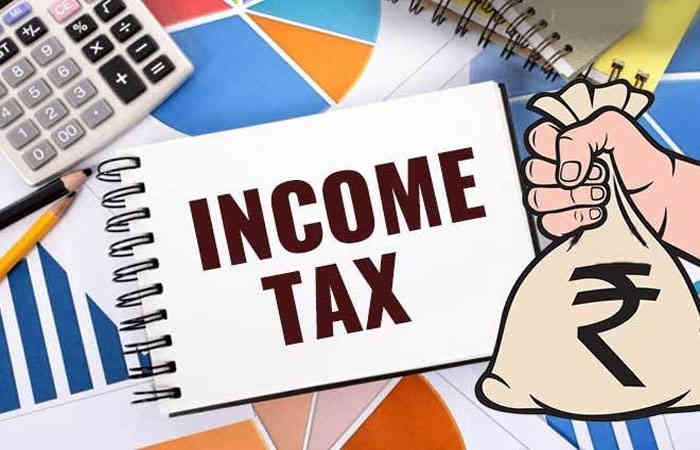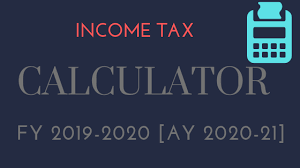

The Income tax calculator is an easy-to-use excel sheet tool that helps you estimate your taxes based on your income after the Union Budget is presented. We have updated our tool in line with the income tax changes proposed in the Union Budget 2020-21.
Income Tax Slab
You will be required to pay a tax depending on the income slab you belong to.
Click Here to access the calculator in excel- Income tax calculator
| Income Slab | Applicable Tax Rate |
| Up to Rs 2.50 lakhs | Nil |
| Above Rs 2.50 lakhs and up to Rs 5 lakhs | 5% |
| Above Rs 5 lakhs and up to Rs 7.5 lakhs | 10% |
| Above Rs 7.5 lakhs and up to Rs 10 lakhs | 15% |
| Above Rs 10 lakhs and up to Rs 12.5 lakhs | 20% |
| Above Rs 12.5 lakhs and up to Rs 15 lakhs | 25% |
| Above Rs 15 lakhs | 30% |
Suppose you have a gross taxable income of Rs 7.50 lakhs after all the deductions/exemptions, your tax will be calculated as follows:
| Income Slab | Applicable Tax Rate | Applicable Income | Tax (in Rs) |
| Up to Rs 2.50 lakhs | No tax | 0 | 0 |
| Above Rs 2.50 lakhs and up to Rs 5 lakhs | 5% | Rs 2.50 lakhs | 12,500 |
| Above Rs 5 lakhs and up to Rs 7.5 lakhs | 10% | Rs 2.50 lakhs | 25,000 |
| Total Tax Payable | 37,500 |
Hence, you will be required to pay a tax of Rs 37,500 (excluding cess) on your gross taxable income i.e. Rs 7.50 lakhs.
Changes in Income Tax Rules
- Rebate under Section 87A changed from Rs 2,500 to Rs 12,500 or 100% of income tax (whichever is lower) for individuals with income below Rs 5 Lakhs (from Rs 3.5 Lakhs)
- Standard Deduction raised for Salaried & Pensioners from Rs 40,000 to Rs 50,000
- Increased Tax for super-rich: Surcharge increased to 25% for income between 2 to 5 Cr. & to 37% for income beyond Rs 5 Cr.
- Additional Tax Deduction of Rs 1.5 lakhs u/s 80EEA on home loans on purchase of affordable home
- Additional Tax Deduction of Rs 1.5 lakhs u/s 80EEB on Auto loans on purchase of Electric vehicles
- No Tax on Notional Rental Income from Second House
- Capital gains exemption on reinvestment in two house properties: Tax payers can now buy two houses on sale of 1 house if the capital gains are less than Rs 2 Cr.. This benefit can be availed only once in lifetime
- TDS threshold increased from Rs 10,000 to Rs 40,000 on Bank Interest Income
Income Tax Calculation
Income tax calculation for the Salaried an example for understanding:
Income from salary is the sum of Basic salary + HRA + Special Allowance + Transport Allowance + any other allowance.
Some components of your salary are exempt from tax, such as telephone bills reimbursement, leave travel allowance. If you receive HRA and live on rent, you can claim exemption on HRA. Calculate exempt portion of HRA, by using this HRA Calculator in excel.
On top of these exemptions, a standard deduction of Rs 40,000 was introduced in budget 2018. This has been increased to Rs 50,000 in budget 2019.
In case you opt for the new tax regime, these exemptions will not be available to you.
Let’s understand income tax calculation under the current tax slabs and new tax slabs (optional) by way of an example.
Monica receives a basic salary of Rs 1,00,000 PM. HRA of Rs 50,000 PM. Special Allowance of Rs 21,000 PM. LTA of Rs 20,000 PA. She pays a rent of Rs 40,000 PM and lives in Delhi.
| Nature | Amount | Exemption/Deduction | Taxable(Old regime) | Taxable(New regime) |
| Basic Salary | 12,00,000 | – | 12,00,000 | 12,00,000 |
| HRA | 6,00,000 | 3,60,000 | 2,40,000 | 6,00,000 |
| Special Allowance | 2,52,000 | – | 2,52,000 | 2,52,000 |
| LTA | 20,000 | 12,000 (bills submitted) | 8,000 | 20,000 |
| Standard Deduction | – | 50,000 | 50,000 | – |
| Gross Total Income from Salary | 16,50,000 | 20,72,000 |
To calculate Income tax, include income from all sources as like below:
- Income from Salary (salary paid by your employer)
- Income from house property (add any rental income, or include interest paid on home loan)
- Income from capital gains (income from sale purchase of shares or house)
- Income from business/profession (income from freelancing or a business or profession)
- Income from other sources (saving account interest income, fixed deposit interest income, interest income from bonds)
Monica has income from interest from savings account of Rs 8,000 and a fixed deposit interest income of Rs 12,000 during the year. She has made some investments to save income tax. PPF investment of Rs 50,000. ELSS purchase of Rs 20,000 during the year. LIC premium of Rs 8,000. Medical insurance paid of Rs 12,000. Here are the deductions she can claim under the old tax regime.
| Nature | Maximum Deduction | Eligible investments/expenses | Amount claimed by Monica |
| Section 80C | Rs.1,50,000 | PPF deposit Rs 50,000, ELSS investment Rs 20,000, LIC premium Rs 8,000. EPF deducted by employer(Neha’s contribution) = Rs 1,00,000 *12% *12 = 1,44,000 | Rs 1,50,000 |
| Section 80D | Rs 25,000 for self Rs 50,000 for parents | Medical insurance premium Rs 12,000 | Rs 12,000 |
| Section 80TTA | 10,000 | Savings account interest 8,000 | Rs. 8,000 |
Calculation of gross taxable income in India (Old regime)
| Nature | Amount | Total |
| Income from Salary | 16,50,000 | |
| Income from Other Sources | 20,000 | |
| Gross Total Income | 16,70,000 | |
| Deductions | ||
| 80C | 1,50,000 | |
| 80D | 12,000 | – |
| 80TTA | 8,000 | 1,70,000 |
| Gross Taxable Income | 15,00,000 | |
| Total tax on above (including cess) | 2,73,000 |
Calculation of gross taxable income in India (New regime)
| Nature | Amount | Total |
| Income from Salary | 20,72,000 | |
| Income from Other Sources | 20,000 | |
| Gross Total Income | 20,92,000 | |
| Total tax on above (including cess) | 3,79,704 |
This is how income tax has been calculated for Monica under the new tax regime
| Up to Rs 2,50,000 | Exempt from tax | 0 |
| Rs 2,50,000 to Rs 5,00,000 | 5% (5% of Rs 5,00,000 less Rs 2,50,000) | 12,500 |
| Rs 5,00,000 to Rs 7,50,000 | 10% (10% of Rs 7,50,000 less Rs 5,00,000) | 25,000 |
| Rs 7,50,000 to Rs 10,00,000 | 15% (15% of Rs 10,00,000 less Rs 7,50,000) | 37,500 |
| Rs 10,00,000 to Rs 12,50,000 | 20% (20% of Rs 12,50,000 less Rs 10,00,000) | 50,000 |
| Rs 12,50,000 to Rs 15,00,000 | 25% (25% of Rs 15,00,000 less Rs 12,50,000) | 62,500 |
| More than Rs Rs 15,00,000 | 30% (30% of Rs 20,92,000 less Rs 15,00,000) | 1,77,600 |
| Cess | 4% of total tax (4% of Rs 12,500 + Rs 25,500+ Rs 37,500 + Rs 50,000 + Rs 62,500 + Rs 1,77,600) | 14,604 |
| Total Income Tax | Rs 12,500 + Rs 25,500+ Rs 37,500 + Rs 50,000 + Rs 62,500 + Rs 1,77,600 + Rs 14,604 | Rs 3,79,704 |
Exemptions/ deductions that are disallowed under the new tax regime
Individual or HUF opting for taxation under the newly inserted section 115BAC of the Act shall not be entitled to the following exemptions/deductions:
(i) Leave travel concession as contained in clause (5) of section 10;
(ii) House rent allowance as contained in clause (13A) of section 10;
(iii) Some of the allowance as contained in clause (14) of section 10;
(iv) Allowance to MPs/MLAs as contained in clause (17) of section 10;
(v) Allowance for the income of minor as contained in clause (32) of section 10;
(vi) Exemption for SEZ unit contained in section 10AA;
(vii) Standard deduction, deduction for entertainment allowance and employment/professional tax as contained in section 16;
(viii) Interest under section 24 in respect of self-occupied or vacant property referred to in sub-section (2) of section 23. (Loss under the head income from house property for the rented house shall not be allowed to be set off under any other head and would be allowed to be carried forward as per extant law);
(ix) Additional deprecation under clause (iia) of sub-section (1) of section 32;
(x) Deductions under section 32AD, 33AB, 33ABA;
(xi) Various deduction for donation for or expenditure on scientific research contained in sub-clause (ii) or sub-clause (iia) or sub-clause (iii) of sub-section (1) or sub-section (2AA) of section 35;
(xii) Deduction under section 35AD or section 35CCC;
(xiii) Deduction from family pension under clause (iia) of section 57;
(xiv) Any deduction under chapter VIA (like section 80C, 80CCC, 80CCD, 80D, 80DD, 80DDB, 80E, 80EE, 80EEA, 80EEB, 80G, 80GG, 80GGA, 80GGC, 80IA, 80-IAB, 80-IAC, 80-IB, 80-IBA, etc). However, deduction under sub-section (2) of section 80CCD (employer contribution on account of the employee in notified pension scheme) and section 80JJAA (for new employment) can be claimed.
Following allowances shall be allowed as notified under section 10(14) of the Act to the Individual or HUF exercising option under the proposed section:
- a) Transport Allowance granted to a divyang employee to meet the expenditure for the purpose of commuting between place of residence and place of duty
- b) Conveyance Allowance granted to meet the expenditure on conveyance in performance of duties of an office;
- c) Any Allowance granted to meet the cost of travel on tour or on transfer;
- d) Daily Allowance to meet the ordinary daily charges incurred by an employee on account of absence from his normal place of duty.
Maximum non-taxable income limit
The maximum limit of non-taxable income for an individual is set at Rs 2.5 lakhs. However, you can also get a rebate of Rs 2,500 under section 87A if you have a total income of less than Rs 3.5 lakhs for FY 2018-19. From FY 2019-20 onward, the rebate has been increased to Rs 12,500 for an income less than Rs 5 lakh. So, that means an individual earning less than 5 lakhs will not be required to pay any income tax from FY 2019-20 onward. If you have tax saving investments under section 80C of up to Rs 1.5 lakhs then you will not have to pay any taxes till Rs 6.5 lakhs
Filing of ITR
If the income of an individual is below the basic exemption limit then he is not required to file income tax returns. Though those who have income less than Rs 2.5L and want to claim an income tax refund can only claim the refund by filing an ITR. Otherwise, it is mandatory to file income tax returns in any other case.
Information Details needed while e-filing of income tax returns
- Basic information such as PAN, Aadhar Card details, and current address.
- All the bank account details held in a financial year.
- Income proofs like current salary details, income from investments (like FDs, savings bank account) etc.
- All the deductions claimed under Section 80 or Chapter VI-A.
- Tax payment details such as TDS and advance tax payments.
One may claim both HRA & deduction on home loan interest
Homeowners, who are paying back their home loan and getting HRA as part of their salary, can avail both the house property-related tax benefits to lower their taxable income.
There can be cases where you work in one city and live on rent, your family resides in another city, and you buy a home where your family is.
A homeowner can claim:
- HRA exemption towards rent payment
- Deduction on home loan interest as per Section 24
- Principal Repayment under Section 80C
Here is an example below:
John lives in Gurgaon and pays a rent of Rs 10,000 per month; he gets an HRA of Rs 15,000. His basic salary is Rs 40,000. He has taken a loan to buy a house in Bangalore where his parents currently live. The interest he pays on the loan for his house is Rs 20,000 per month.
John can claim HRA as follows:
The amount of tax exemption from HRA will be a minimum of these three:
- HRA received = Rs. 15,000
- 40% of Basic since he lives in Gurgaon = Rs. 16,000
- Rent paid – 10% of Basic = Rs.10,000 – Rs. 4,000 = Rs. 6,000
Therefore, HRA exempt = Rs.6,000. Remaining HRA of Rs 15,000 – Rs 6,000 = Rs.9,000 will form part of his taxable income under salaries on account of HRA.
The income from house property and claiming interest on home loan deduction will be allowed as follows:
Gross Annual Value of the property is Nil (because his parents live in the house property)
Less: Deduction on Interest on home loan = Rs 2,00,000 (limited to Rs.2,00,000 for self-occupied house)
Income Tax Deductions
Section 80 Deduction Table
| Section | Deduction on | Allowed Limit (maximum) FY 2018-19 |
| 80C | Investment in PPF – Employee’s share of PF contribution – NSCs – Life Insurance Premium payment – Children’s Tuition Fee – Principal Repayment of home loan – Investment in Sukanya Samridhi Account – ULIPS – ELSS – Sum paid to purchase deferred annuity – Five year deposit scheme – Senior Citizens savings scheme – Subscription to notified securities/notified deposits scheme – Contribution to notified Pension Fund set up by Mutual Fund or UTI. – Subscription to Home Loan Account scheme of the National Housing Bank – Subscription to deposit scheme of a public sector or company engaged in providing housing finance – Contribution to notified annuity Plan of LIC – Subscription to equity shares/ debentures of an approved eligible issue – Subscription to notified bonds of NABARD |
Rs. 1,50,000 |
| 80CCC | For amount deposited in annuity plan of LIC or any other insurer for a pension from a fund referred to in Section 10(23AAB) | – |
| 80CCD(1) | Employee’s contribution to NPS account (maximum up to Rs 1,50,000) | – |
| 80CCD(2) | Employer’s contribution to NPS account | Maximum up to 10% of salary |
| 80CCD(1B) | Additional contribution to NPS | Rs. 50,000 |
| 80TTA(1) | Interest Income from Savings account | Maximum up to 10,000 |
| 80TTB | Exemption of interest from banks, post office, etc. Applicable only to senior citizens | Maximum up to 50,000 |
| 80GG | For rent paid when HRA is not received from employer | Least of : – Rent paid minus 10% of total income – Rs. 5000/- per month – 25% of total income |
| 80E | Interest on education loan | Interest paid for a period of 8 years |
| 80EE | Interest on home loan for first time home owners | Rs 50,000 |
| 80CCG | Rajiv Gandhi Equity Scheme for investments in Equities | Lower of – 50% of amount invested in equity shares; or – Rs 25,000 |
| 80D | Medical Insurance – Self, spouse, children Medical Insurance – Parents more than 60 years old or (from FY 2015-16) uninsured parents more than 80 years old |
– Rs. 25,000 – Rs. 50,000 |
| 80DD | Medical treatment for handicapped dependent or payment to specified scheme for maintenance of handicapped dependent – Disability is 40% or more but less than 80% – Disability is 80% or more |
– Rs. 75,000 – Rs. 1,25,000 |
| 80DDB | Medical Expenditure on Self or Dependent Relative for diseases specified in Rule 11DD – For less than 60 years old – For more than 60 years old |
– Lower of Rs 40,000 or the amount actually paid – Lower of Rs 1,00,000 or the amount actually paid |
| 80U | Self-suffering from disability : – An individual suffering from a physical disability (including blindness) or mental retardation. – An individual suffering from severe disability |
– Rs. 75,000 – Rs. 1,25,000 |
| 80GGB | Contribution by companies to political parties | Amount contributed (not allowed if paid in cash) |
| 80GGC | Contribution by individuals to political parties | Amount contributed (not allowed if paid in cash) |
| 80RRB | Deductions on Income by way of Royalty of a Patent | Lower of Rs 3,00,000 or income received |
Net Loss under the head ‘Income from House Property’ = (-) Rs 2,00,000 which will be added to his taxable income.
Reference
www.incometaxindia.gov.in
Financial and Business expert having 30+ Years of vast experience in running successful businesses and managing finance.





